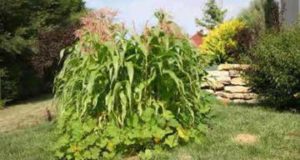 Like people, plants just naturally get along better with a small circle of friends, but they don’t always get along with the entire garden. That’s why before you plant a garden of any kind, you should do some research to find which plants go well together. If you’re planting a regular ground garden, section off different areas so that they can all be planted with different kinds of companion plants. Companion planting works the same for all types of plants including veggies, fruits, herbs, and flowers. If you plan to have any kind of mix of these in your ground garden or raised bed garden, then choose your seeds and sprouts carefully before you plant them. If you don’t, you could end up stunting the growth of the plants, repelling certain kinds of plants, or attracting harmful bugs to chow down on your garden.
Like people, plants just naturally get along better with a small circle of friends, but they don’t always get along with the entire garden. That’s why before you plant a garden of any kind, you should do some research to find which plants go well together. If you’re planting a regular ground garden, section off different areas so that they can all be planted with different kinds of companion plants. Companion planting works the same for all types of plants including veggies, fruits, herbs, and flowers. If you plan to have any kind of mix of these in your ground garden or raised bed garden, then choose your seeds and sprouts carefully before you plant them. If you don’t, you could end up stunting the growth of the plants, repelling certain kinds of plants, or attracting harmful bugs to chow down on your garden.
Vegetables
Vegetables are usually the first thing that people plant in their gardens. They grow the best, have the most variety, and you can eat them. There’s no downside to planting veggies, but you have to plant them with plants that encourage growth, or else your garden is going to look a little pathetic and taste just as bad. It is possible to force your garden to yield a healthy crop despite not using companion gardening, but that requires a lot of manmade fertilizers and chemicals that stimulate unnatural growth. If you want an organic garden, then you have to rely entirely on your own mulch, compost, and companion plants.
The first step after tilling up your garden for the spring or getting your raised beds ready is choosing what you want to plant. Then, it’s just a simple matter of looking up what neighboring plants will help the ones you want grow. A good crop of vegetables that appear in common dinners and lunches are tomatoes, various types of beans, cucumbers, potatoes, corn, carrots, and maybe another type of root vegetable like turnips or beets. This is a good variety, and it’s not too many; so when the companion plants are paired with them, you will have a pretty good haul of vegetables come harvest time.
Starting with tomatoes, you want to clear a good section off. Tomatoes, unless they’re the hanging variety, take up a lot of space. So you should plant them with one companion plant because you won’t have much room for more. Really, sunlight and right type of soil mixture will help tomatoes the most. When they get growing, they don’t stop unless they aren’t in a lot of direct sunlight. Companion plants for tomatoes are onions, chives, and carrots. None of those take up too much space, and since tomatoes grow above ground, there’s plenty of space for root vegetables. If you were going to plant carrots anyways, this is a good match. If you want some onions in the mix, then go ahead with those.
Beans come next. They pair well with corn and potatoes, and this goes for almost any type of bean including bush, pole, regular, and soybeans. They also go well with cucumbers. What you don’t want to plant next to beans are onions, garlic, or chives.
Cucumbers should be planted next to beans, corn, or peas, but they shouldn’t be planted next to potatoes. Most vegetables can be paired up like this so you don’t have to plant a whole other garden just to be companion plants.
Potatoes grow best paired with beans and corn, but you should avoid planting any type of squash, cucumbers, or tomatoes nearby. Turnips grow well next to peas, but even though beets are related to turnips, you should plant beets next to onions and avoid beans and peas.
Herbs
Fruits generally grow well together regardless of what type they are, but that’s generally not the case with herbs. Herbs grow a lot like vegetables, and they can be paired with companion herbs to stimulate growth and flavor. Like vegetables, you might want to grow a moderate-sized herb garden and fill it with typical herbs you use for cooking and flavoring common dinners and food. Let’s say you want to plant rosemary, thyme, basil, chives, dill, garlic, mint, and maybe some horseradish. These are typical herbs unless you’re looking to open your own apothecary, and in most cases, these herbs can be grown pretty close to your vegetables, even among some of your vegetables.
Rosemary actually pairs well with several different kinds of vegetables, and most of them are in the hypothetical vegetable garden previously mentioned. Rosemary goes well with carrots, beans, and corn, and drives away carrot flies and beetles that attack beans. Thyme doesn’t need to be planted in the vegetable garden, so it can be grown alone in its own little planter or with a variety of other herbs. It does drive away cabbage worms though, so it you plan on planting cabbage or kale, plant it near thyme. If you plant basil next to tomatoes, it will improve the growth and flavor of both the tomatoes and the basil. Basil also repels mosquitoes and flies. Chives we already know are good for tomatoes, but you can also grow them next to carrots to improve their growth and flavor as well. Dill is only good for cabbage, so unless you’re growing cabbage or kale, you can grow thyme and dill on their own or next to each other in a separate herb garden. This also goes for garlic. Mint is good for tomatoes as well, but be careful about planting them next to each other because they both spread out like crazy. If you plant horseradish at the corners of your potato section, it will help drive away potato bugs and allow you to harvest a larger crop.
Flowers
Besides herbs, there are also some flowers that can help stimulate growth in herbs and vegetables and also repel garden pests of all kinds. The main flower that acts as a general natural pesticide is marigold. If you plant a ring of marigolds around your entire garden, it will keep away almost every single kind of harmful bug and insect that wants to munch on all your hard work. Marigolds also keep out slugs, which can be one of the most destructive forces that invade gardens. You can also place a ring of salt around your garden, but salt can sink into the soil and harm plant growth.
Petunias protect beans, and nasturtiums help keep the aphid population down. A smattering of flowers around your vegetable and herb garden also makes it aesthetically pleasing and gives a splash of color among all the green. Henbit is also a general insecticide, and small amounts of dandelions increase the aromatic properties of most herbs. If you can believe it, stinging nettle is good to grow around most herbs and vegetables because it makes them hardier and more resistant to disease and spoiling. It also increases the essential oil content in many herbs. This is especially good if you are harvesting a large amount of herbs for their oils.
A garden is designed to work together, again, just like people are designed to work together. Sometimes we don’t all do so well when we’re crammed into one space, but given the option to be around the people we like, they often help us grow, thrive, and maybe they improve our flavor a little as well.











